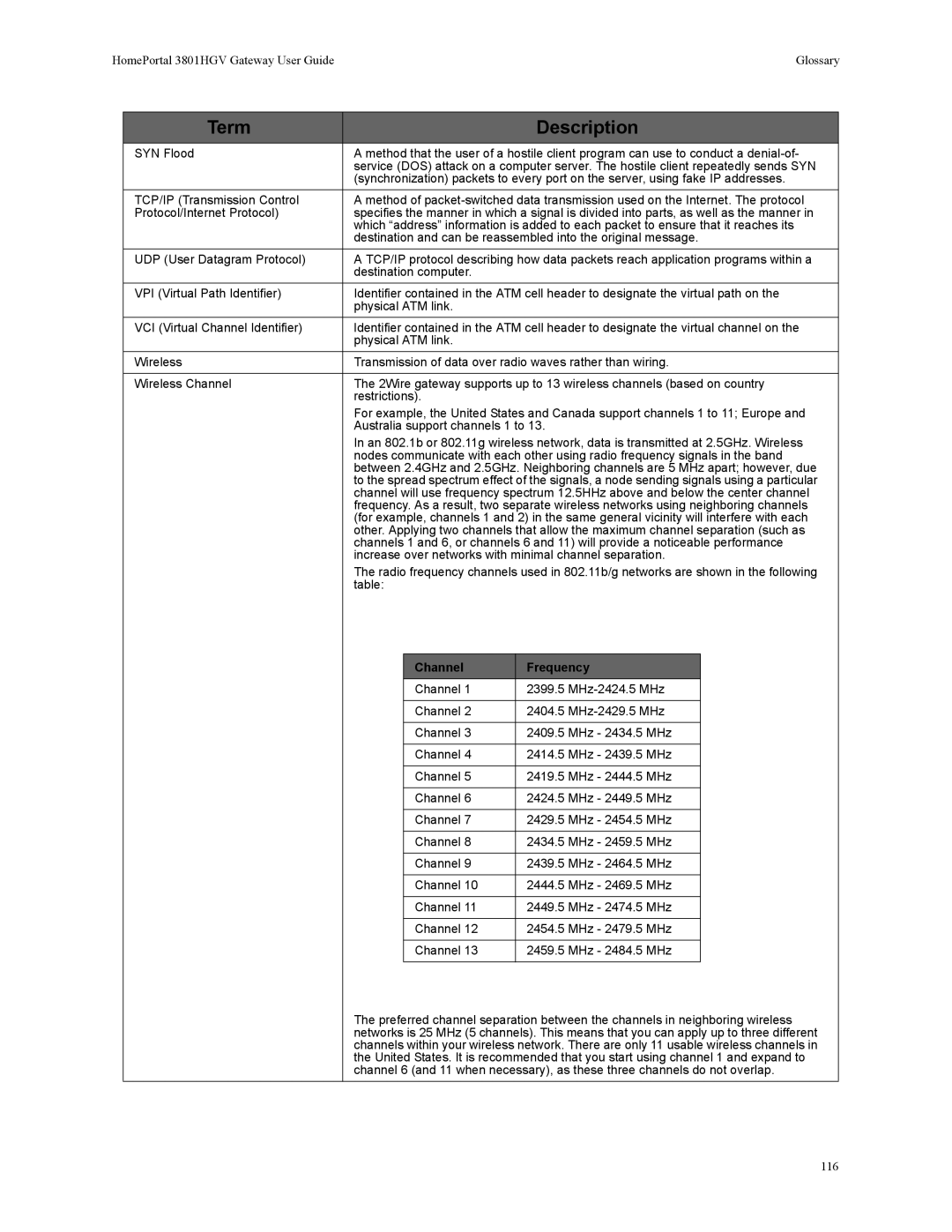
HomePortal 3801HGV Gateway User Guide | Glossary |
Term | Description |
SYN Flood | A method that the user of a hostile client program can use to conduct a |
| service (DOS) attack on a computer server. The hostile client repeatedly sends SYN |
| (synchronization) packets to every port on the server, using fake IP addresses. |
TCP/IP (Transmission Control | A method of |
Protocol/Internet Protocol) | specifies the manner in which a signal is divided into parts, as well as the manner in |
| which “address” information is added to each packet to ensure that it reaches its |
| destination and can be reassembled into the original message. |
UDP (User Datagram Protocol) | A TCP/IP protocol describing how data packets reach application programs within a |
| destination computer. |
VPI (Virtual Path Identifier) | Identifier contained in the ATM cell header to designate the virtual path on the |
| physical ATM link. |
VCI (Virtual Channel Identifier) | Identifier contained in the ATM cell header to designate the virtual channel on the |
| physical ATM link. |
Wireless | Transmission of data over radio waves rather than wiring. |
|
|
Wireless Channel | The 2Wire gateway supports up to 13 wireless channels (based on country |
| restrictions). |
| For example, the United States and Canada support channels 1 to 11; Europe and |
| Australia support channels 1 to 13. |
| In an 802.1b or 802.11g wireless network, data is transmitted at 2.5GHz. Wireless |
| nodes communicate with each other using radio frequency signals in the band |
| between 2.4GHz and 2.5GHz. Neighboring channels are 5 MHz apart; however, due |
| to the spread spectrum effect of the signals, a node sending signals using a particular |
| channel will use frequency spectrum 12.5HHz above and below the center channel |
| frequency. As a result, two separate wireless networks using neighboring channels |
| (for example, channels 1 and 2) in the same general vicinity will interfere with each |
| other. Applying two channels that allow the maximum channel separation (such as |
| channels 1 and 6, or channels 6 and 11) will provide a noticeable performance |
| increase over networks with minimal channel separation. |
| The radio frequency channels used in 802.11b/g networks are shown in the following |
| table: |
Channel | Frequency | |
Channel 1 | 2399.5 | |
|
|
|
Channel 2 | 2404.5 | |
|
|
|
Channel 3 | 2409.5 | MHz - 2434.5 MHz |
|
|
|
Channel 4 | 2414.5 | MHz - 2439.5 MHz |
|
|
|
Channel 5 | 2419.5 | MHz - 2444.5 MHz |
|
|
|
Channel 6 | 2424.5 | MHz - 2449.5 MHz |
|
|
|
Channel 7 | 2429.5 | MHz - 2454.5 MHz |
|
|
|
Channel 8 | 2434.5 | MHz - 2459.5 MHz |
|
|
|
Channel 9 | 2439.5 | MHz - 2464.5 MHz |
|
|
|
Channel 10 | 2444.5 | MHz - 2469.5 MHz |
|
|
|
Channel 11 | 2449.5 | MHz - 2474.5 MHz |
|
|
|
Channel 12 | 2454.5 | MHz - 2479.5 MHz |
|
|
|
Channel 13 | 2459.5 | MHz - 2484.5 MHz |
|
|
|
The preferred channel separation between the channels in neighboring wireless networks is 25 MHz (5 channels). This means that you can apply up to three different channels within your wireless network. There are only 11 usable wireless channels in the United States. It is recommended that you start using channel 1 and expand to channel 6 (and 11 when necessary), as these three channels do not overlap.
116
